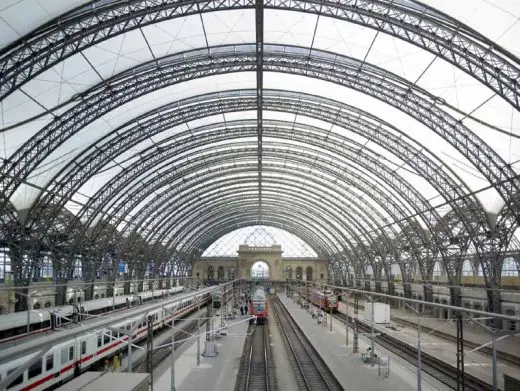The Cube Dresden: first carbon concrete building, German architecture design project in Saxony
The Cube Dresden: First Carbon Concrete Building
22 Apr 2020
Architects: HENN
The Cube Dresden: first carbon concrete building in the World
Location: Fritz-Foerster-Platz, Technical University of Dresden (a German “University of Excellence”), Dresden, Germany
Groundbreaking Ceremony for the World’s First Carbon Concrete Building: The Cube
The original concept for the pioneering carbon concrete building:

image © HENN
The Cube Dresden Carbon Concrete Building, Saxony
March 2020 – HENN architekten has developed the concept design for the world’s first building made of carbon concrete, The Cube. The 220-m² experimental building combines a laboratory and event rooms, and sets an example of architectural and structural innovation at the Technical University of Dresden (a German “University of Excellence”).
Two types of concrete are assembled in The Cube:

image © HENN
Centrally located on Fritz-Foerster-Platz, the meeting and exhibition rooms entice the public to enter and form a focal point for the students on the campus. The co-existence of the laboratory and assembly functions stands for intellectual exchange, cross-fertilization and proximity to research.
Modelling of the merging and twisted design of the wall and roof:

image © HENN
The development of the experimental building was the result of a complex process involving Professor Manfred Curbach and his Institute for Solid Construction at the TU Dresden, as well as designers, architects and experts for material performance, visualizers and model builders from architectural office HENN. The design process was an open one in which multiple types of expertise and technical test runs simultaneously interacted, in what is both an innovative research experiment and an artistic project.
Innovative materials for sustainable building
In a time of climate crisis and resource scarcity, architects and planners in particular are called upon to create new construction techniques for our future built environment. Reinforced concrete is the world’s most used building material, but its production is resource-intensive and polluting. Carbon concrete can drastically minimize resource consumption, being a material that can be up to four times lighter (because of the reduced structural sections) and four times stronger.
Architectural research is consciously tackling these challenges. The test building for carbon concrete is a showcase project of the larger research project on innovative building materials called “C³ – Carbon Concrete Composite”, financed by the German Federal Ministry of Education and Research. In this project, carbon concrete is being researched and developed as a new combination of carbon and high-performance concrete.
The light yet robust carbon fibres of this new building material allow for flexible and resource-saving construction. Switching to the innovative material can reduce the CO2 emissions from construction by up to 50%. With The Cube, HENN is making a significant contribution to the development and implementation of this future-oriented construction technology.
A futuristic and artistic design
Besides the technical achievements, the design is also of central importance. It reinterprets the fluid textile nature of the carbon fibres through the fluid merging of the ceiling and walls in a single form, suggesting a future architecture in which environmentally-conscious design is paired with formal freedom and a radical rethinking of the most basic architectural elements.
The wall and ceiling are no longer separate elements but functionally merge into one another as an organic continuum. The roof is opened up by a skylight, which additionally emphasizes the basic organic shape. The design of the building impressively exemplifies the design possibilities of carbon concrete, with the building itself becoming a sculpture.
The Cube Dresden, Saxony – Building Information
Project Information
Concept Design: HENN
Architects: AIB GmbH
Client: Technical University Dresden
Co-operation Partners:
Betonwerk Oschatz GmbH
Hochschule für Technik, Wirtschaft und Kultur Leipzig, Institut für Betonbau
Technische Universität Dresden – Institut für Massivbau
Assmann Beraten & Planen GmbH
texton e. V.
Hoch- und Tiefbau GmbH & Co. KG Sebnitz
Location: Dresden
Area: 220 m2
Programme: Event Space, Research Laboratory
Production Hall Building in Germany images / information from wurm + wurm Architects
Location: Dresden, Saxony, Germany
Dresden Architecture
Dresden Architecture Designs – chronological list
Dresden Architecture – Selection
Dresden Militärhistorisches Museum
Daniel Libeskind Architect

photo © Hufton+Crow Photography
Dresden Military History Museum
Dresden Station redevelopment
Design: Foster + Partners

photo © Nigel Young
Dresden Railway Station – Stirling Prize shortlisted
Centre for Regenerative Therapies Dresden
Design: Henn Architekten

image from architect
Centre for Regenerative Therapies Dresden
Jena Building Revitalization, Dresden, Saxony
Design: wurm+wurm architekten

photo from architect
Reconstruction Multifunctional Building, Jena
Göpel Electronic Building, Jena
Design: wurm + wurm architekten · ingenieure
Göpel Electronic Building
Die Gläserne Manufaktur – Volkswagen site
Henn Architekten
Gläserne Manufaktur
Comments / photos for the GFC Coswig Dresden Architecture design by Architects HENN page welcome









